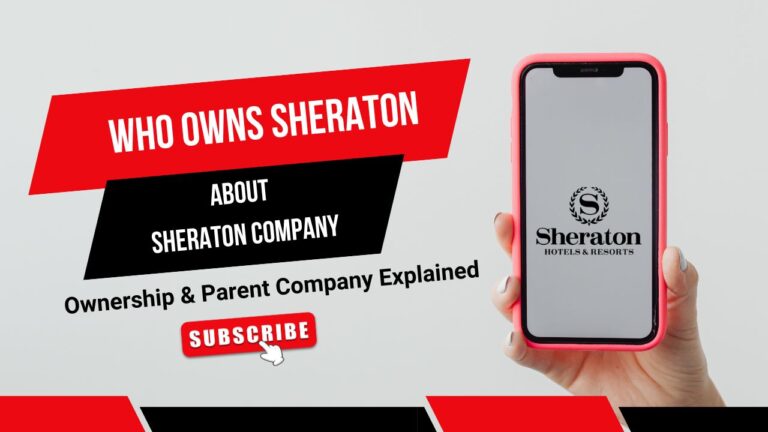Who Owns UPS? Ownership & Major Shareholders Explained
Introduction
United Parcel Service (UPS) is one of the most well-known logistics companies in the world, providing package delivery, supply chain management, and freight transportation services.
Since its founding in 1907, the company has expanded its operations across more than 220 countries and territories, making it a global leader in the shipping and logistics industry.
UPS has built a reputation for reliability, efficiency, and innovation, constantly adapting to new challenges in e-commerce, business logistics, and international trade.
With a fleet of over 127,000 vehicles, a vast network of distribution centers, and an integrated technology system, UPS remains a dominant force in the industry.
Despite its size and prominence, many people wonder about UPS’s ownership and corporate structure.
Unlike companies that are subsidiaries of larger parent corporations, UPS operates as an independent entity with a unique shareholder system that has evolved over time.
Since its initial public offering (IPO) in 1999, UPS has maintained a balance between public shareholders and internal ownership through its employee stock programs.
This article explores the history of UPS’s ownership, its shareholder structure, and how its current corporate framework influences its business strategy and future growth.
Who is UPS’s Parent Company?
UPS does not have a parent company and operates as an independent, publicly traded corporation.
Listed on the New York Stock Exchange (NYSE) under the ticker symbol UPS, the company is managed by its own board of directors and executive leadership team.
This independence allows UPS to make strategic decisions based on its business goals rather than being influenced by a larger conglomerate.
While many large logistics and shipping companies operate under holding groups or umbrella corporations, UPS remains a standalone company, maintaining its brand identity and long-term vision.
Unlike FedEx, which operates under a corporate structure with multiple divisions, UPS maintains a single brand presence with integrated services.
This structure gives it a competitive advantage in maintaining consistent service quality across all logistics operations.
UPS’s independence also ensures that its shareholders—ranging from institutional investors to individual employees—have a direct stake in the company’s performance.
Over the years, UPS has strategically positioned itself to remain self-sustaining while expanding globally, leveraging its financial strength and operational expertise to stay ahead in the competitive shipping industry.
UPS’ Ownership History
Founding and Early Ownership
UPS was originally founded in 1907 by James E. Casey and Claude Ryan in Seattle, Washington.
Initially named the American Messenger Company, it started as a small courier service focused on local package deliveries.
The business grew steadily, and by 1913, it acquired a Model T Ford—the first delivery vehicle in its fleet.
In 1919, the company expanded outside of Seattle for the first time, rebranding itself as United Parcel Service (UPS).
During these early years, ownership was primarily held by its founders, along with a small group of employees who played key roles in the company’s growth.
As UPS expanded, it began offering more advanced services, including consolidated delivery, where multiple packages were delivered to a single neighborhood in a single trip.
This innovation allowed the company to streamline costs and improve efficiency. By the 1930s and 1940s, UPS was expanding across the West Coast and eventually to the East Coast.
During this time, ownership remained within a private structure, primarily controlled by the company’s key executives and employees who had invested in the business.
This model allowed UPS to maintain strong internal control and a long-term focus, avoiding external pressure from outside investors.
Expansion and Growth
By the mid-20th century, UPS had established itself as a dominant player in the U.S. delivery industry.
In 1953, the company introduced air service, marking a major shift toward faster deliveries.
Over the following decades, UPS expanded internationally, first entering Canada in 1975 and then Europe in 1976.
As the company grew, it reinvested its profits into expanding infrastructure, acquiring new technologies, and improving operational efficiency.
Despite its large size, UPS remained a privately held company, with ownership concentrated among its employees and executives.
During the 1980s and 1990s, UPS continued to strengthen its presence worldwide, launching UPS Airlines in 1988, a major step toward global air freight dominance.
The company’s continued growth put pressure on its private ownership model, as the need for greater investment capital became apparent.
While the company was still privately controlled, discussions about going public started gaining momentum.
The company’s strong financial performance and demand for expansion opportunities led to the eventual decision to transition to a publicly traded company in 1999.
Transition to a Publicly Traded Company
On November 10, 1999, UPS went public in one of the largest initial public offerings (IPOs) in U.S. history, raising over $5.5 billion.
The decision to go public was driven by the need for increased capital to fund future expansions and investments in new technologies.
Before the IPO, UPS was 100% employee-owned, with a structure that allowed employees to hold shares in the company.
With the IPO, a significant portion of the company’s shares became available to institutional and retail investors.
Despite going public, UPS maintained a dual-class share structure, ensuring that employees and executives retained significant control over corporate decisions.
While this transition opened the company to a broader range of investors, it also ensured that its founding principles and long-term vision remained intact.
The move to public ownership allowed UPS to continue its aggressive expansion, including major acquisitions and advancements in e-commerce logistics.
Key Acquisitions and Strategic Changes
Since becoming a publicly traded company, UPS has pursued a number of strategic acquisitions to expand its capabilities.
One of its major acquisitions was Overnite Transportation in 2005, which helped UPS enter the freight industry.
Other notable acquisitions include Coyote Logistics, which strengthened its supply chain and freight brokerage services, and Mail Boxes Etc., which was later rebranded as The UPS Store.
These acquisitions have allowed UPS to diversify beyond package delivery and establish itself as a leader in global logistics.
In addition to acquisitions, UPS has continuously adapted to technological advancements and market demands.
The rise of e-commerce has significantly shaped UPS’s business model, leading to innovations in last-mile delivery solutions and investment in automation.
By integrating artificial intelligence, data analytics, and electric delivery vehicles, UPS has stayed ahead of industry trends while ensuring sustainability in its operations.
UPS’ Shareholder Structure
Major Institutional Investors
As a publicly traded company, UPS has a diverse shareholder base that includes institutional investors, retail investors, and company insiders.
Some of the largest shareholders are investment firms like Vanguard Group, BlackRock, and State Street Corporation.
These firms collectively own a significant percentage of UPS’s publicly traded shares, giving them substantial influence over corporate governance decisions.
Institutional investors play a key role in shaping UPS’s strategic direction through their voting power in shareholder meetings.
While they do not control the company outright, their influence can be seen in decisions related to executive compensation, business expansion, and sustainability initiatives.
Since UPS is a well-established and profitable company, it remains an attractive investment for these financial institutions.
Individual Shareholders & Insider Ownership
In addition to institutional investors, a portion of UPS shares is held by individual investors, including current and former employees.
The company’s Employee Stock Purchase Program allows UPS employees to acquire shares at discounted rates, fostering a culture of ownership.
Many high-level executives and board members also hold significant stakes in the company, aligning their financial interests with the company’s long-term success.
UPS maintains a dual-class share structure, which consists of Class A and Class B shares.
Class A shares are primarily held by employees and executives and come with voting rights, ensuring that the company’s leadership has a strong say in major decisions.
Meanwhile, Class B shares are publicly traded and do not carry the same voting privileges.
This system helps maintain UPS’s employee-driven culture while allowing external investors to participate in its financial growth.
Conclusion
UPS has established itself as a dominant force in the global logistics industry, balancing public ownership with a strong employee-driven culture.
Its dual-class share structure ensures that employees and executives maintain influence, while institutional investors provide the financial backing needed for continued growth.
Since its 1999 IPO, UPS has successfully navigated market changes, expanding its services and investing in innovative solutions to remain competitive.
Looking ahead, UPS is well-positioned to thrive in an increasingly digital and e-commerce-driven world.
By focusing on automation, sustainability, and strategic acquisitions, the company continues to enhance its global operations and meet evolving customer demands.
With its commitment to innovation and operational efficiency, UPS is set to maintain its leadership in the logistics sector while adapting to the challenges and opportunities of the future.


